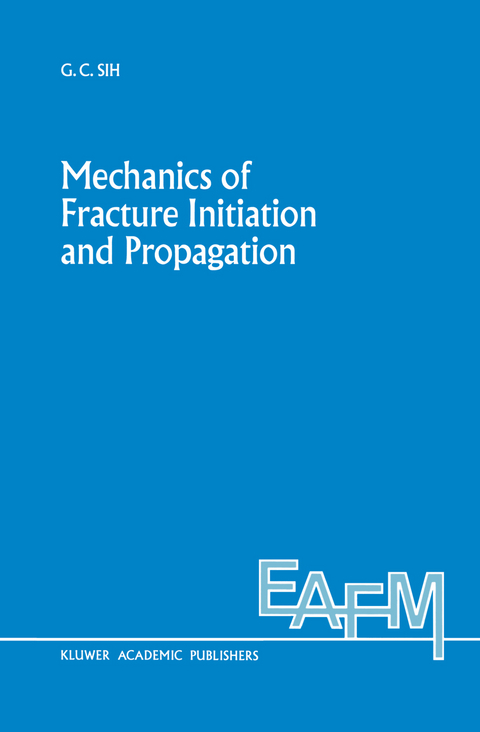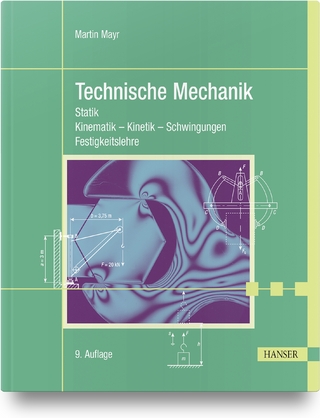
Mechanics of Fracture Initiation and Propagation
Springer (Verlag)
978-94-010-5660-1 (ISBN)
The assessment of crack initiation and/or propagation has been the subject of many past discussions on fracture mechanics. Depending on how the chosen failure criterion is combined with the solution of a particular theory of continuum mechanics, the outcome could vary over a wide range. Mod elling of the material damage process could be elusive if the scale level of observation is left undefined. The specification of physical dimension alone is not sufficient because time and temperature also play an intimate role. It is only when the latter two variables are fixed that failure predictions can be simplified. The sudden fracture of material with a pre-existing crack is a case in point. Barring changes in the local temperature,* the energy released to create a unit surface area of an existing crack can be obtained by considering the change in elastic energy of the system before and after crack extension. Such a quantity has been referred to as the critical energy release rate, G e, or stress intensity factor, K Ie. Other parameters, such as the crack opening displacement (COD), path-independent J-integral, etc. , have been proposed; their relation to the fracture process is also based on the energy release concept. These one-parameter approaches, however, are unable simultaneously to account for the failure process of crack initiation, propagation and onset of rapid fracture. A review on the use of G, K I, COD, J, etc. , has been made by Sih [1,2].
1. A special theory of crack propagation.- 1.1 Historical remarks.- 1.2 The strain energy density concept.- 1.3 Fundamental hypotheses on crack initiation and direction.- 1.4 Prediction of crack growth direction.- 1.5 Intrinsic property of strain energy density factor.- 1.6 Mixed mode fracture criterion.- 1.7 Concluding remarks.- 1.8 References.- 2. A three-dimensional strain energy density factor theory of crack propagation.- 2.1 Preliminary remarks.- 2.2 Generalized stress field near crack border.- 2.3 Strain energy density factor.- 2.4 Basic assumptions of the theory.- 2.5 Minimum values of S.- 2.6 Application of the S-theory to the elliptical crack problem.- 2.7 Shape of fracture increment.- 2.8 Concluding remarks.- 2.9 Appendix 2.1: Elliptical crack in tension.- 2.10 Appendix 2.2: Combined Mode I and III loading.- 2.11 Appendix 2.3: Elliptical crack in compression.- 2.12 References.- 3. Straiu energy density theory applied to plate-bending and shell problems.- 3.1 Introductory remarks.- 3.2 Strain energy density factor theory.- 3.3 Bending and twisting of cracked plates.- 3.4 Direction of crack growth.- 3.5 Minimum strain energy density factors and allowable bending moments.- 3.6 Additional results on plates.- 3.7 Shell theory with shear deformation.- 3.8 Symmetric loading on shell.- 3.9 References.- 4. Dynamic crack problems — strain energy density fracture theory.- 4.1 Preliminary remarks.- 4.2 Strain energy density criterion in elastodynamics.- 4.3 Mixed mode impact.- 4.4 Standing plane waves impinging on a crack.- 4.5 Crack bifurcation.- 4.6 Summary and conclusions.- 4.7 References.- 5. Strain energy density and surface layer energy for blunt cracks or notches.- 5.1 Background information.- 5.2 Surface layer energy.- 5.3 Strain energy density theory.- 5.4 Theembedded elliptical notch.- 5.5 Two external notches.- 5.6 Concluding remarks.- 5.7 References.- 6. Thermoelastic and hygrothermoelastic behavior of cracks.- 6.1 Introduction.- 6.2 Linear thermoelasticity.- 6.3 Fracture caused by nonuniform temperature changes.- 6.4 Simultaneous application of thermal and mechanical loading.- 6.5 Thermally induced slow crack growth.- 6.6 Hygrothermoelasticity.- 6.7 Effect of heat/moisture/load on crack behavior.- 6.8 Failure enhanced by temperature and moisture changes.- 6.9 References.- 7. Failure of composites as predicted by the strain energy density theory.- 7.1 Preliminary remarks.- 7.2 Srain energy density criterion.- 7.3 Failure of fiber, matrix or interface.- 7.4 Unidirectional fiber/matrix composite.- 7.5 Comparison of results obtained from anisotropic and matrix cracking model.- 7.6 Angle-ply laminates.- 7.7 Impact and cracking of unidirectional composites.- 7.8 Concluding remarks.- 7.9 Appendix 7.1: Calculation of gross mechanical properties of unidirectional composites.- 7.10 Appendix 7.2: E-glass-epoxy resin composites.- 7.11 Appendix 7.3: Stainless steel-aluminum composite.- 7.12 References.- 8. Experimental fracture mechanics: strain energy density criterion.- 8.1 Preliminary remarks.- 8.2 Mechanical properties of materials.- 8.3 Fracture mechanics discipline.- 8.4 Incremental crack growth.- 8.5 Fatigue crack growth: a path-dependent process.- 8.6 Concluding remarks.- 8.7 References.- 9. Isoenergy density theory: exchange of surface and volume energy.- 9.1 Introduction.- 9.2 Surface energy: micro- and macrocrack models.- 9.3 Volume energy: local and global instability.- 9.4 Damage resistance concept: scaling in size and time.- 9.5 Interaction between surface and volume energy: nonhomogeneous energy dissipation.- 9.6 References.- Author index.
| Reihe/Serie | Engineering Applications of Fracture Mechanics ; 11 |
|---|---|
| Zusatzinfo | XXII, 410 p. |
| Verlagsort | Dordrecht |
| Sprache | englisch |
| Maße | 155 x 235 mm |
| Themenwelt | Naturwissenschaften ► Physik / Astronomie ► Mechanik |
| Technik ► Bauwesen | |
| Technik ► Fahrzeugbau / Schiffbau | |
| Technik ► Maschinenbau | |
| ISBN-10 | 94-010-5660-9 / 9401056609 |
| ISBN-13 | 978-94-010-5660-1 / 9789401056601 |
| Zustand | Neuware |
| Haben Sie eine Frage zum Produkt? |
aus dem Bereich


